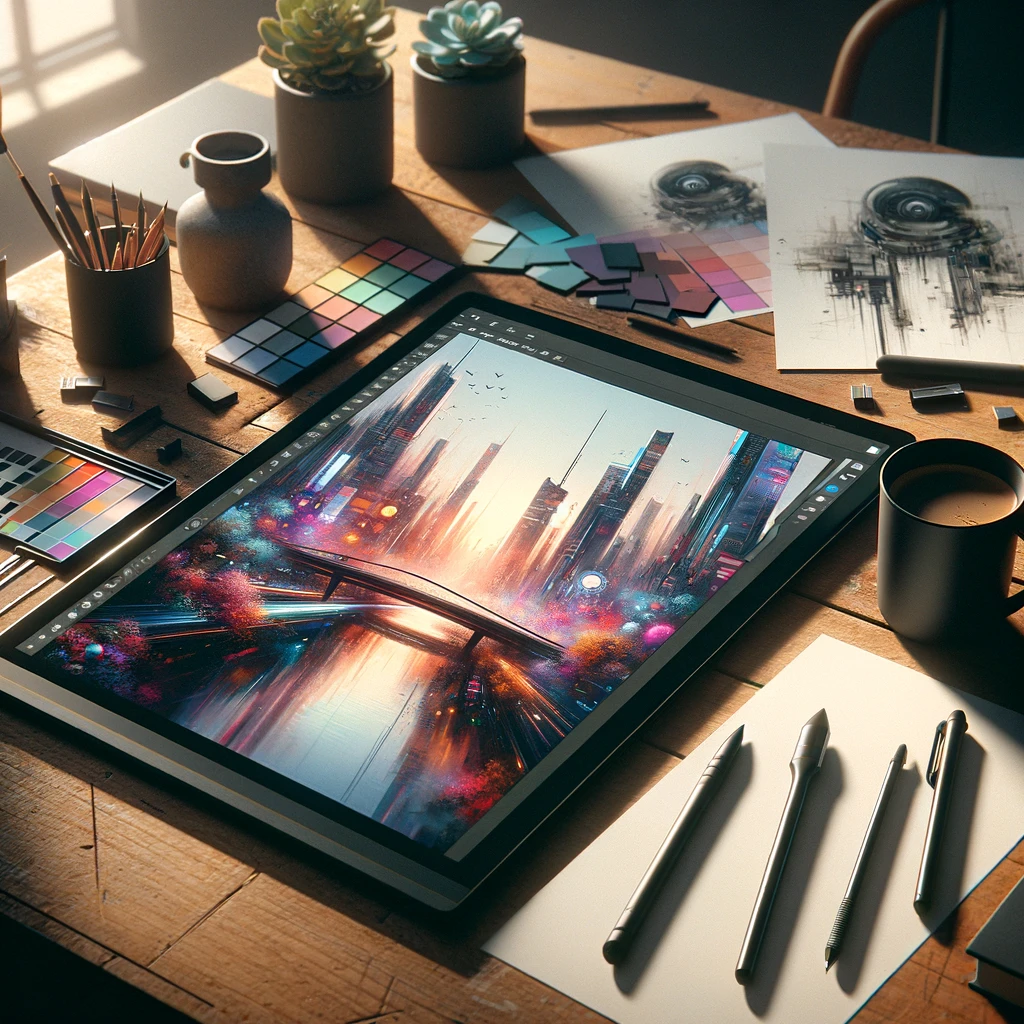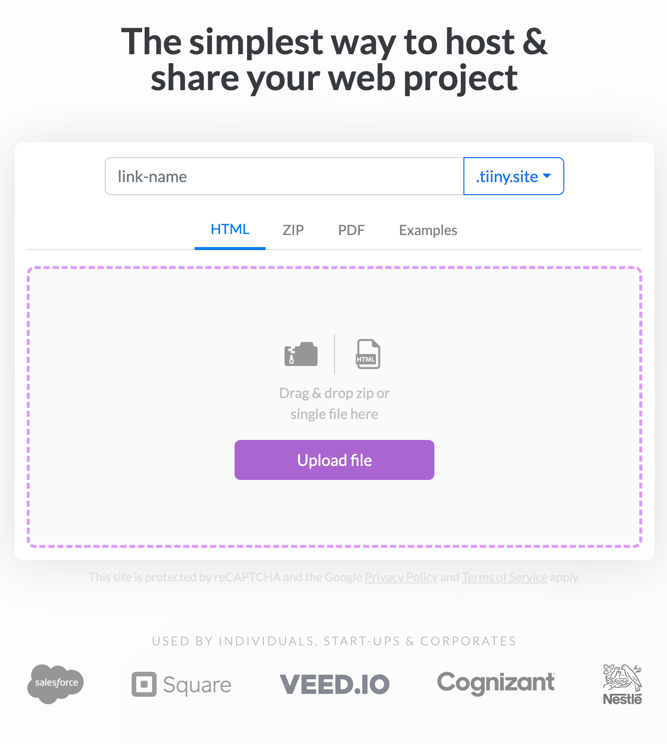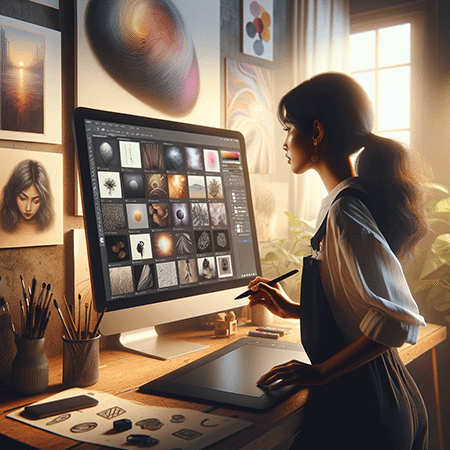- Define your artistic and professional goals
- Tell your story well
- Curate your work strategically
- Showcase your creative process
- Tell the story behind each piece
- Pay Attention to technical presentation
- Create a user-friendly website
- Get feedback and act on it
- Engage with your audience
- Keep your portfolio updated and evolving
- How to host and share your portfolio for free
- Free portfolio hosting with Tiiny.host
- Next steps
- FAQ: Digital Art Portfolio
Creating a digital art portfolio can be daunting.
Where do you start? What do you include?
What’s the point you’re trying to make?
You must do more than showcase your work. Your portfolio should tell a convincing professional story—especially if you are early in your career.
This article identifies 12 must-have characteristics of a compelling digital art portfolio, including how to best host and share your portfolio with others.
Let’s take a look.
Define your artistic and professional goals
What are the artistic and professional goals of your portfolio?
Ask yourself, “What do I want my viewers to do after seeing my work?”
Do you want them to buy your finished art? Hire you to create art for them? Get a scholarship to a college or university? What?
Next, ask, “Why should they bother doing this?”
What makes your art unique? What’s your style or preferred medium? Where are you at in your professional journey? What proof can you give of your competence? What’s in it for them?
The answers to these questions should come across clearly in your portfolio.
You must tell a compelling story of yourself, your experience, your work, and your professionalism. All these things add up to the value you offer as an artist.
Tell your story well
We’ve already asked a lot of questions that must be answered. How you answer them must convince the viewer that you know what you’re doing.
To do this, tell a story with your artwork. Arrange your work in a way that takes viewers on a journey through your art and process.
If you keep their attention throughout the story—and your work is good—they may be impressed enough to give you what you want.
Remember: A story has a beginning, middle, and end. Tell your story well.
Organize your portfolio to show where you want the story to begin. Then, take your viewers strategically through your exhibits. Finally, end with a call to action that tells them clearly what you want them to do now that they’ve seen you and your work.

Curate your work strategically
When it comes to a portfolio, less is often more.
Don’t publish everything you’ve ever created. Instead, select the work that represents you in the best light and fits your storyline.
If you don’t have enough paid, professional work examples to complete your story, then put some time in and create sample projects highlighting your skills.
The point is to show what you can do. You can’t just tell them, they won’t believe you.
Showcase your creative process
Viewers want to see how you do your job. Include the sketches, wireframes, or notes that led to the final version. This provides insight into your creative process and demonstrates your problem-solving abilities.
Showing, not telling, the story of each exhibit makes the overall narrative much stronger.
Tell the story behind each piece
I’ve emphasized the need to show rather than tell. Still, the two can effectively work together. Adding descriptions to your work can add depth and context that might not be immediately obvious. Explain the concept behind the piece, the project goal, or any challenges you faced during its creation. This narrative can provide a deeper understanding and connection to your work.
Pay Attention to technical presentation
Make sure your production quality is consistent throughout. The portfolio is only as strong as its weakest exhibit.
Each piece of art in your portfolio should be presented in the best possible way. This means high-resolution images and careful attention to color accuracy. How your work is displayed significantly influences a viewer’s perception of its quality.
Create a user-friendly website
Your online portfolio is shared as a website. On websites, a good user experience is vital.
Make sure your website is easy to navigate. You want your viewers to enjoy looking at and navigating through your portfolio.
Whatever your viewers are looking for—contact information, your resume, or specific works—they should find it quickly and intuitively.
Ensure your website has a responsive design. This means that it displays properly on both desktop and mobile devices.
RECOMMENDED ARTICLE: How to Build a Static Website
Get feedback and act on it
Artists need feedback. Get it from peers, mentors, and members of your target audience. What works for them? What doesn’t?
Be open to criticism and use it to improve your portfolio and your website experience.
Engage with your audience
You can encourage your viewers to become involved with your art by including a blog or social media feeds on your website.
Share your experiences, works in progress, or thoughts on the creative process.
An engaged audience is more likely to remember you and your work. They might even become fans, employers, or collectors of your art.
Keep your portfolio updated and evolving
Your portfolio should be a living process, not a one-off production.
As you create new work, evaluate if it deserves a spot in your portfolio.
Eliminate weaker work and add more recent work to keep your story accurate and up-to-date. Now and again, it may even require a complete overhaul to keep it fresh and relevant.
Don’t let your story become obsolete or boring. Keep it alive and thriving.
How to host and share your portfolio for free
Your digital art portfolio is more than just an online gallery. It’s your professional story, your digital calling card.
It should reflect who you are as an artist, highlight your best work, and invite viewers into your world.
When it comes time to host and share your portfolio, you don’t want your hosting to be as time-consuming and complicated as making the portfolio itself.
And free hosting would be nice, right?
Free portfolio hosting with Tiiny.host
Our service, Tiiny.host, makes technical hosting problems go away. For free.
Traditional paid hosting services require special SFTP apps to upload your files. Then, you must configure the web pages and related components using a special dashboard. This all takes time, effort, and technical know-how.
Tiiny.host securely automates the entire hosting process, requiring only three simple steps. In seconds, your portfolio is live online and ready to share.
Here’s how it works:

Once you visit Tiiny.host’s home page, you’re only moments away from your portfolio being live on the web.
Here are the three steps:
- Give your portfolio website a name.
- Drag and drop your zipped portfolio website onto the upload form.
- Click the “Upload file” button, sign in, or register for a free account.
That’s it.
Tiiny.host’s automated hosting system performs all the steps that traditional hosting services make you do manually.
Why worry about the technicalities of traditional hosting when all you need to do is drag and drop? That’s why we exist—to make web hosting as simple as possible.
Tiiny.host’s advanced features
Your portfolio is now ready to share with anyone online.
Did I mention that you can do all this for free? Yes, it’s true.
You can email or post the unique web address or even generate a QR code to let your viewers scan their way to your website. All it takes is one click to generate a QR code.
Simple. Free. Secure. Professional.
If you require more advanced features, such as password protection, custom domains, or file editing tools, you can explore our paid tiers at Tiiny.host/pricing. See all our features and low-cost subscriptions.
Next steps
If you still have questions after reading this article, or there are issues you aren’t quite clear on concerning portfolios or hosting, you can reach our awesome customer service team at Tiiny.host/help. You don’t need an account. We’re eager to answer your inquiries. No commitment is required.
Host your digital art portfolio at Tiiny.host.
FAQ: Digital Art Portfolio
What is the most important thing to consider when creating a digital art portfolio?
The most crucial aspect is the curation of your content. You should showcase only your best work representing your skills and artistic style. This selection process demonstrates your ability to critique and present your work professionally.
How often should I update my digital art portfolio?
You should update your portfolio whenever you complete a new piece representing an evolution or improvement in your work. Regular updates (every few months or at least once a year) are essential to show you are active and developing as an artist.
What platforms can I use to share my digital art portfolio?
There are numerous traditional technical platforms, such as Squarespace, Wix, or WordPress. Simpler, faster, and more secure hosting is available from Tiiny.host. Choose the one that makes your life easier, focusing on art, not technology.



